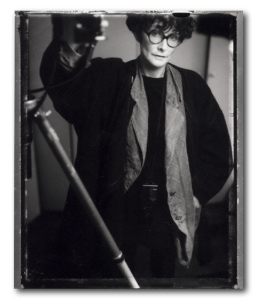
Sarah Moon
2006 Honoree / Achievement In Fine Art
Sarah Moon was born in 1941, in Paris, to a Franco-American father and a German-Algerian-French mother, both Jewish. As the Nazis arrived in the city of light, so the family escaped to England, where the photographer spent her early years.
She studied drawing and started out as a model. She moved behind the camera in 1970 when she was already 29. That late start seems to have provided time and space for her exotic style to develop in private, untrammelled by the world’s demands. Her tonal palette is restricted and gated, though lush and original. “I don’t really like colour,” she has said. “To make it work for me, I have to mess with it. I believe that the essence of photography is black and white. Colour is but a deviance.”
More than any other photographer, she shaped the visual atmosphere of fashionable London in the period between the demise of its swinging sixties and the rise of punk. In her pictures, there was a child-like playing with historical imagery — of the 1930s and the 1890s, in particular — and a fragility to the models. “Fresh little foals with long legs, bright faces and round dolly eyes” in the words of Barbara Hulanicki, founder and creator of Biba, the women’s fashion outlet for which Moon was almost house photographer. She took the same look and feel — of slightly drugged and bruised delicacy — into her editorial work.
In 1972, she became the first woman to photograph the Pirelli calendar. She shot in Paris, at the Villa des Tilleuls, in a rich, blurry colour reminiscent of Degas’ paintings of ballerinas. The models are small women, childlike, with rosebud lips and dressed, mostly, in archaic underwear. What little bare flesh there is seems accidental — and quite unvoyeuristic. The pictures are certainly sensual but quite unsexual. The air is of a fin-de-siècle brothel in which the customers and bosses have gone home, leaving the girls to themselves. The Villa des Tilleuls was the Paris headquarters of the Gestapo.
Hers is a world of young women — girls, almost. The few men in it are hidden, sometimes behind animal masks. Her fascination is with shapes. “The curve of the neck, the balance of the hips, the gesture of the hand. It’s not always the face that dictates.” A child from above, caught and framed by a thump of light. A 1977 picture, ‘Nu’— a naked woman, seated, with her head and face torn from the image. Dramatic, narrative-laden, quite unsalacious. An unprecedented and radical take on the 3000-year history of the Western nude.
Her pictures were the public face of Cacharel for twenty years. She worked for French Elle, Italian Vogue and shot campaigns for Comme des Garçons, Chanel, Rykiel, Miyake and Lacroix. She moved on from the fashion world, though, particularly after 1985, into art galleries and the film world. She even made a pop video, for Khaled’s Aïcha.
She lives in Paris, in no little style, in the 14th arrondissement and is married to Robert Delpire, an art publisher.
